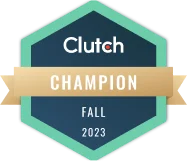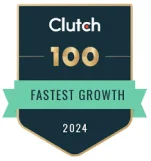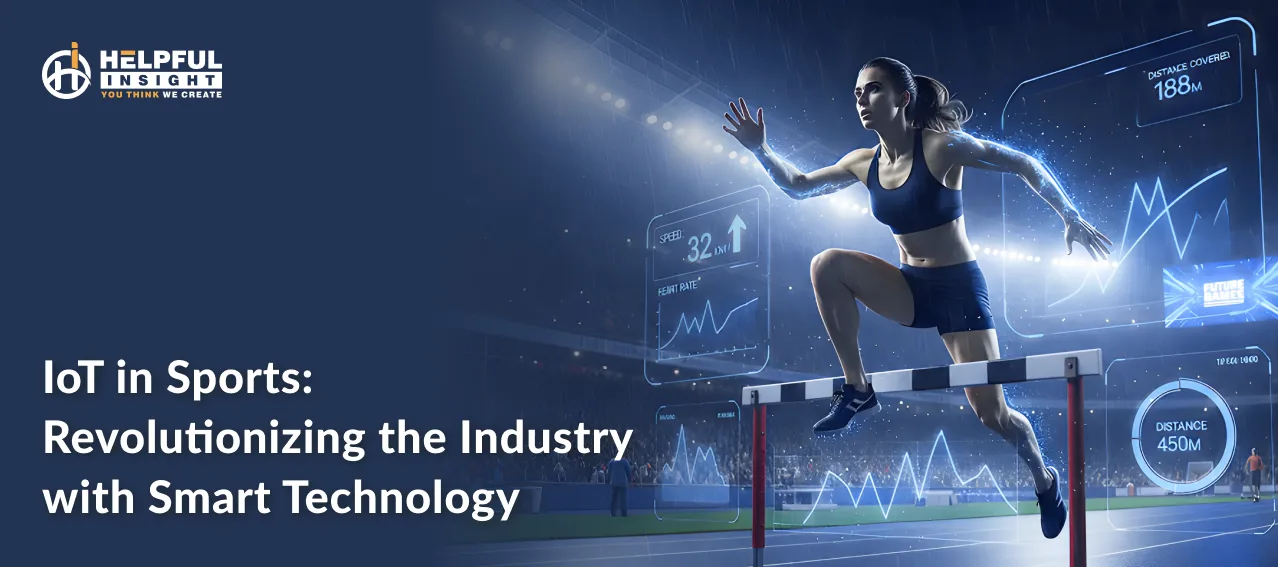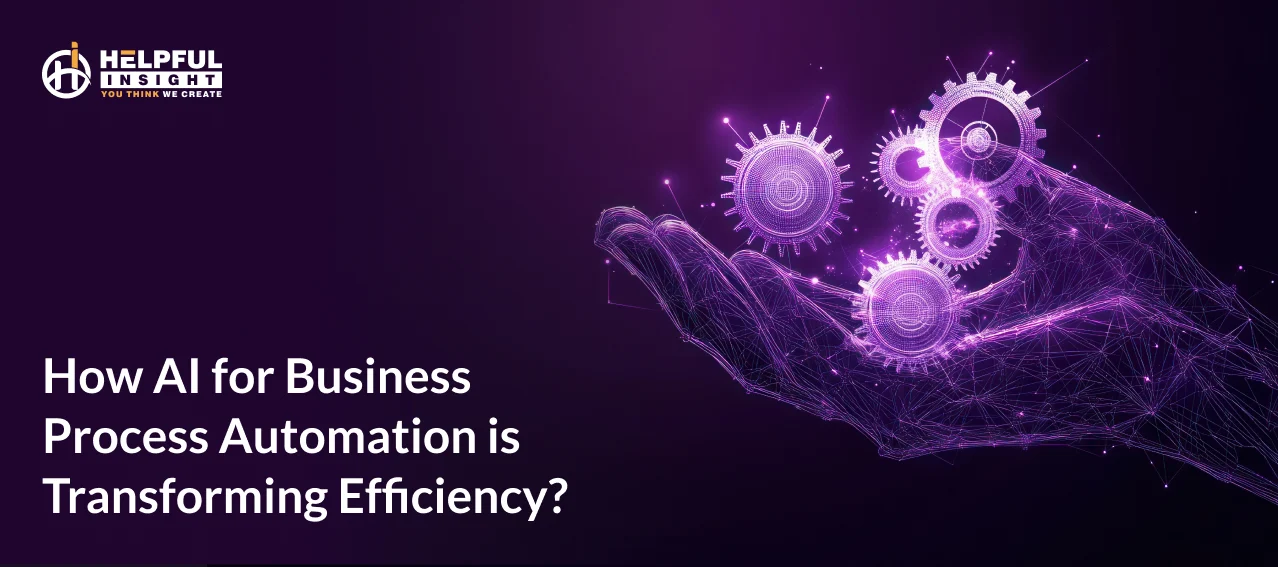“Control your surroundings with internet services and experience the power of IoT.”
Since its discovery in 1989, the internet has been serving the global population with a unique identity and quick data access. Businesses can connect it with the computer or other hardware devices through an IoT app development guide for various technologies and services. It is widely used by entrepreneurs to modify various healthcare, fintech, logistics, e-commerce, and edtech systems. For example, IoT in education provides real-time features, such as automated attendance, student LMS, and smartboards.
Different IoT apps are made with several components that we will further explore in the sections below. According to a reputed journal, the growth in 5G technology will rise to $153.2 billion in 2029 from $82.5 billion in 2025 at a rate of 18.8% CAGR. So, you must approach the best IoT development companies before investing money.
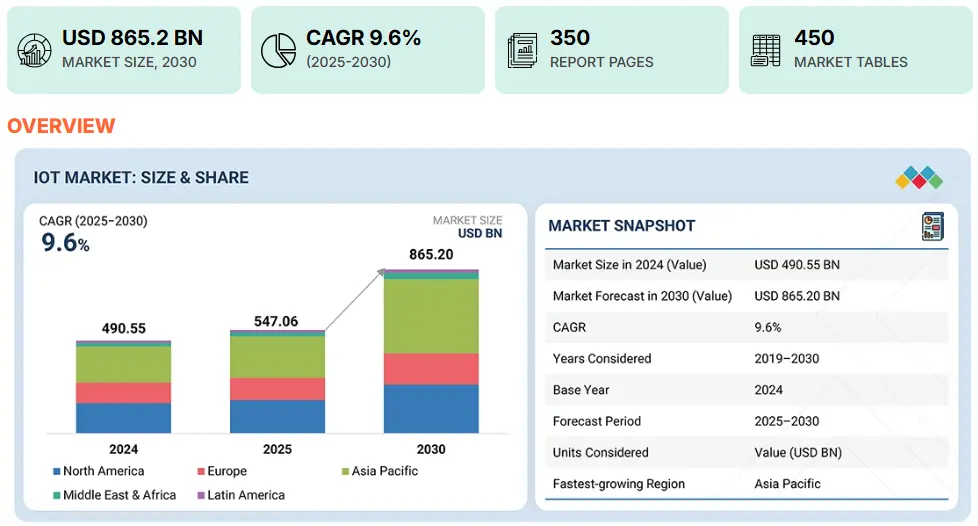
Here, you will know about what components make up an IoT system, key technology trends, the development cost, and best practices. After that, entrepreneurs can hire skilled IoT app developers to create prototypes and build real applications. So, let’s move on.
Stats On The Current Global IoT Market
The integration of hardware devices with mobile apps has increased, giving rise to various IoT and wearable app development solutions. Businesses have started investing in this sector because there is a lot of scope to generate revenue and increase users:
- The global IoT market is growing at a rate of 9.7% CAGR between 2025 and 2030.
- It is expected that it will reach a total revenue of $1.7 trillion in 2030 from $1.1 trillion in 2025.
- The USA is generating a revenue of $379.9 billion in 2025, which is the maximum among other countries.
- In 2025, the revenue of the healthcare IoT market is $93.3 billion, and it will reach $143.3 billion by 2030, growing at a rate of 9% CAGR.
- In the USA, the market of the Smart Cities segment will reach $27.1 billion by the end of 2025.
- The growth rate in China is around 7.9% CAGR, which will expand its revenue to $27.2 billion in 2030.
The idea to create an IoT mobile application is resulting in an opportunity for businesses to make huge profits through advanced technologies. Entrepreneurs must use AI or Blockchain to develop modern mobile IoT app solutions for high user reach and global brand success.
What Is IoT App Development?
You all know that IoT stands for Internet of Things, meaning various devices are operated through an online connection and without human interference. An IoT mobile application provides multiple services, from gathering physical raw data to digital data storage. This technology is also used in custom web development to automate servers, which has a wide range of applications in various industries.
Additionally, businesses have the choice to use IoT in blockchain or integrate Artificial Intelligence and IoT to customize tasks and provide data security. So, it is beneficial for you to hire an IoT app development company that has both experience and skilled developers for developing smartly integrated wearable mobile applications.
- Smart Homes: Control lighting, security, and appliances remotely for convenience and energy efficiency.
- Healthcare Monitoring: Track patient vitals in real-time for proactive medical care.
- Industrial Automation: Optimize machinery performance and predictive maintenance in factories.
Key Components Of An IoT-Enabled System
An IoT platform involves multiple components like hardware, software, and networking. Before using AI in IoT, you should approach an IoT application development company to learn about these elements. In this section, we will study them deeply:
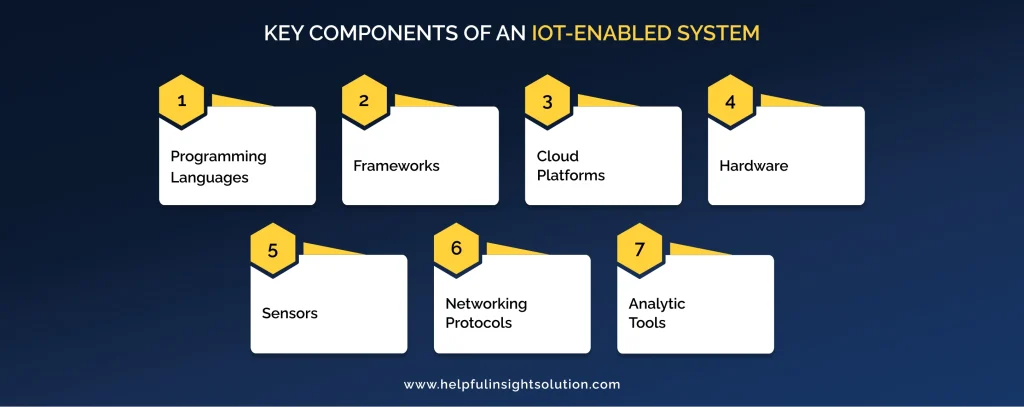
1. Programming Languages
Various programming languages are used for developing IoT-enabled mobile applications. C++ and Java are used to make object-specific solutions for dynamic platforms. Additionally, you can hire IoT app developers to make apps with Python that can be used for AI automation.
| Tool / Language | Description |
| Python | Widely used for IoT due to its simplicity and extensive libraries for data processing, machine learning, and device communication. |
| C | Ideal for programming microcontrollers and embedded systems where performance and low-level hardware control are essential. |
| JavaScript (Node.js) | Enables real-time, event-driven communication in IoT devices, especially for web-based interfaces. |
| Java | Platform-independent and scalable, used in large-scale IoT systems and Android-based IoT applications. |
| Rust | Ensures high performance with memory safety, making it great for secure and reliable IoT firmware development. |
2. Frameworks
Different frameworks are available to combine hardware devices with software and APIs. You must use this component before targeting IoT app development solutions to provide a specific environment. ThingSpeak is among the common platforms used by most of the developers.
| Framework | Description |
| Node-RED | A visual programming tool for wiring together hardware devices, APIs, and online services. |
| Kaa IoT Platform | An open-source middleware framework for building, managing, and analyzing connected devices. |
| DeviceHive | Provides cloud-based APIs for device communication, management, and data analytics. |
| ThingSpeak | An IoT analytics platform and API that allows data collection and visualization in MATLAB. |
| Zetta | Based on Node.js, designed for creating real-time, API-based IoT servers. |
3. Cloud Platforms
Cloud services are used for data storage and to manage servers that receive, process, and send data. Hiring top IoT development companies is beneficial for hosting and maintaining cloud platforms. In the case of e-learning app development, to manage LMS portals, you need Cloud for course management.
| Platform | Description |
| AWS IoT Core | Securely connects IoT devices to the AWS cloud for data storage, processing, and analytics. |
| Microsoft Azure IoT Hub | Centralized IoT service for managing devices, data, and security in the Azure ecosystem. |
| Google Cloud IoT Core | Connects and manages globally distributed devices with integrated data analytics and ML. |
| IBM Watson IoT Platform | Offers cognitive analytics, real-time insights, and AI capabilities for IoT systems. |
| Oracle IoT Cloud | Provides secure connectivity, analytics, and automation for industrial IoT applications. |
4. Hardware
Arduino is one of the most widely used IoT hardware in which software programs can be installed. You can target multiple IoT app development solutions for crop monitoring, humidity sensing, and data gathering. For advanced services like Wi-Fi connection, you can use Raspberry Pi or ESP32.
| Hardware/Board | Description |
| Raspberry Pi | A compact, affordable computer often used as an IoT gateway or edge device. |
| Arduino | An open-source microcontroller platform widely used for prototyping IoT solutions. |
| ESP32 | Low-cost, Wi-Fi + Bluetooth microcontroller ideal for IoT projects requiring wireless communication. |
| BeagleBone Black | A Linux-based microcontroller board used for industrial and advanced IoT applications. |
| Intel Edison | Compact module designed for IoT and wearable devices with high performance. |
5. Sensors
There are various sensors, actuators, and transducers available to gather different information like temperature, moisture, or altitude. You can hire IoT application developers to use these devices with accuracy. They send the collected data over the server and process information to provide results.
| Sensor Type/Example | Description |
| DHT22 (Temperature & Humidity) | Measures environmental temperature and humidity for smart home or industrial monitoring. |
| MQ-135 (Gas Sensor) | Detects air quality and harmful gases like CO₂, NH₃, and benzene. |
| HC-SR04 (Ultrasonic Sensor) | Measures distance using ultrasonic waves; used in robotics and obstacle detection. |
| PIR Sensor (Motion) | Detects infrared radiation from moving bodies and is often used in security systems. |
| LDR (Light Dependent Resistor) | Measures light intensity, used in smart lighting and solar tracking systems. |
6. Networking Protocols
For better and seamless communication, various networking protocols are used. These connectivity modules include MQTT for email notifications, HTTPS for data privacy, and LoRaWAN for distance communication. They combine IoT and security to prevent unauthorized user access.
| Protocol | Description |
| MQTT (Message Queuing Telemetry Transport) | Lightweight publish/subscribe protocol ideal for low-bandwidth IoT communication. |
| CoAP (Constrained Application Protocol) | Designed for resource-constrained devices; supports RESTful interaction. |
| HTTP/HTTPS | Standard web communication protocol for cloud-based IoT systems. |
| Zigbee | Low-power, short-range communication protocol used in home automation. |
| LoRaWAN | Long-range, low-power wireless protocol for connecting battery-operated IoT devices. |
7. Analytic Tools
To represent the data in a graphical or pictorial format, you must use APIs of different analytical tools. For using premium versions, you can hire a full-stack development company at affordable rates. They provide skilled IoT application developers who can implement these tools without any error.
| Tool | Description |
| Power BI | Microsoft’s data visualization tool for real-time IoT dashboards and analytics. |
| Tableau | Offers advanced visualization and analysis for large IoT datasets. |
| Apache Spark | Open-source big data engine used for large-scale IoT data processing and stream analytics. |
| Kibana (with Elasticsearch) | Visualizes IoT log and metric data in real-time dashboards. |
| Google Data Studio | Provides free, easy-to-use analytics and visualization capabilities for IoT data. |
Top Real-World IoT Use Cases & Trends
Several real-world IoT trends are helping businesses to deliver unique and safe mobile solutions, like IoT in security, to users. It is beneficial to connect with a reliable IoT application development company to get familiar with these use cases before investment:
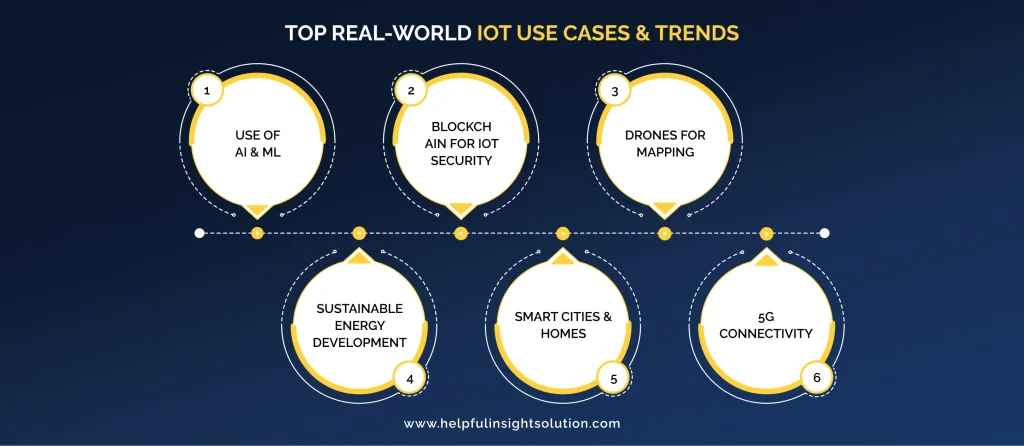
1. Use Of AI & ML
For deploying advanced IoT app development solutions, you may use Artifical Intelligence and Machine Learning algorithms. This technology can automate data generation, improve user personalization, and predict upcoming events. In healthcare app development, AI can be used to monitor vital health symptoms like blood pressure or sugar level.
- Predictive Maintenance: IoT sensors collect performance data, while AI algorithms predict equipment failures.
- Smart Healthcare Monitoring: AI-powered IoT wearables analyze real-time patient information to detect heart rate fluctuations or oxygen level drops.
Read Also: How Much Should You Budget for AI and Machine Learning Integration in Your App?
2. Blockchain For IoT Security
Using Blockchain in IoT applications can empower users’ privacy and data protection. It is primarily applicable in the finance and logistics industries, where security of digital assets and critical information is a must. Various encrypted algorithms and cryptographic techniques are used to safeguard IoT applications from malicious attacks.
- Supply Chain: IoT sensors record product movement, and blockchain ensures full traceability from origin to delivery.
- Secure Smart Contracts: Blockchain-based smart contracts allow devices to securely exchange data between smartly integrated platforms.
3. Drones For Mapping
It is one of the most widely used trends in the present time for different purposes. IoT-powered drones are used for crop monitoring in agriculture, videography in event management, and surveying in construction. In this, drones are also used for IoT device security through different algorithmic patterns like facial recognition and voice commands.
- Agriculture Land Surveying: IoT-enabled drones map large farmland areas, analyzing soil quality, crop health, and irrigation.
- Disaster Management: Drones equipped with IoT sensors create 3D maps, helping rescue teams assess damage and plan recovery operations.
4. Sustainable Energy Development
There is a high demand for green energy resources like wind, water, and thermal in various industries. Businesses are using IoT application development services to create sustainable and energy-efficient platforms that reduce carbon emission. Long-range IoT devices like LoRaWAN are widely used for fast communication and less energy consumption.
- Smart Grids: IoT devices monitor and manage real-time electricity demand, while AI optimizes energy distribution to reduce wastage.
- Renewable Energy: IoT sensors track the performance of solar panels and wind turbines, optimizing output and detecting faults.
5. Smart Cities & Homes
It is a common trend seen in developing countries like India, where technologies like IoT are emerging rapidly. Businesses are investing in mobile app development for home automation and IoT-enabled public facilities. So, you can approach a leading IoT mobile app development company to create platforms that can transform local services.
- Traffic Management: IoT-based systems use real-time data from connected vehicles and cameras to reduce congestion and enhance road safety.
- Smart Home Automation: IoT devices control lighting, heating, and security systems through voice assistants and mobile apps.
6. 5G Connectivity
Mobile connections and internet connectivity are important to send or receive various forms of data. The integration of Internet of Things and Cybersecurity can improve networking through different protocols like MQTT or HTTPS. This ensures a smooth exchange of data in large numbers, having a huge amount of memory through multiple security OSI layers.
- Autonomous Vehicles: 5G enables ultra-fast communication between IoT sensors, vehicles, and infrastructure, ensuring real-time decision-making.
- Industrial Automation: Factories leverage 5G-connected IoT devices for precise robotic control and remote equipment monitoring.
Integration Of IoT With Other Technologies
To build IoT applications with smart and secure features, it is important to combine modern technologies such as AI. Businesses must hire an IoT app development agency that can seamlessly integrate these advanced and cutting-edge technologies in IoT apps:

1. Cybersecurity
The IoT and cybersecurity can be used combinedly to develop smartly integrated surveillance cameras or image-sensing devices. They are used for safety in various industries like logistics, banking, healthcare, and real estate.
2. Artificial Intelligence
The integration of IoT and AI is beneficial for businesses because it can enhance workflow and streamline various operations. You must use AI development services to build IoT apps that can personalize user events and recommend solutions accordingly.
3. Blockchain
Blockchain is used to develop advanced IoT security solutions through cryptography and different encryption methods. It helps to prevent the theft of users’ personal data, digital assets, and transactional records, offering a safe environment.
4. AR/VR
Implementation of AR/VR technology can improve overall user experiences through visual and thematic satisfaction. As a business investor, you must hire an IoT app development company that can easily combine both technologies.
What Is The IoT App Development Cost In 2026?
Multiple factors, such as using Blockchain for Internet of Things or app complexity, affect the IoT app development cost. The average cost to create an IoT app is between $10,000 and $30,000, which can vary due to these market elements. Let’s study those factors with respective cost tables:
1. Project Complexity
The cost to build an IoT application is majorly dependent on the complexity level of the project. For example, the price to integrate IoT in supply chain management for a delivery app with simple tracking features. This development cost may expand as the number of features and devices increases.
| Complexity Level | Average Cost (USD) | Timestamp |
| Simple | $6,000-$10,000 | 2 to 3 months |
| Intermediate | $10,000-$15,000 | 3 to 5 months |
| Complex | $15,000-$20,000 | 5 to 8 months |
| Advanced | $20,000-$25,000 | 8 to 12 months |
2. Hardware Integration
The cost to implement IoT in logistics and transportation systems is also affected by different hardware devices. Various sensors and testing equipment are affordable due to cost-effective manufacturing. But some microcontrollers, Wi-Fi modules, and cloud hardware are expensive for ordinary businesses.
| Component | Estimated Cost (USD) |
| IoT Sensors & Devices | $2,000-$10,000 |
| Microcontrollers/Gateways | $1,500-$8,000 |
| Connectivity Modules (Wi-Fi, BLE, 5G) | $1,000-$6,000 |
| Prototyping & Testing Equipment | $2,000-$7,500 |
| Cloud Integration Hardware Setup | $1,200-$5,000 |
Read Also: 10 Outstanding Apps Created Using the Flutter Framework
3. Service Charges
To find out the estimated price of IoT mobile app development services, businesses can use our cost calculator platform. Cloud and API integration must be third-party because they are expensive in the market. Data storage solutions are cheaper and can be implemented at reasonable prices.
| Component | Estimated Cost (USD) |
| Cloud Hosting & IoT Platform | $3,000-$15,000 |
| Data Storage & Analytics | $2,000-$10,000 |
| API & Third-Party Service Integration | $1,000-$5,000 |
4. Software Development
Businesses can use IoT application development services for creating smartly integrated mobile, web, or embedded apps. The cost is low for making IoT-enabled databases, security, and firmware solutions. For mobile and desktop applications, the price gets increased because of the complex framework.
| Component | Estimated Cost (USD) |
| Mobile/Web App Development | $10,000-$40,000 |
| Firmware Development | $5,000-$20,000 |
| Database & Cloud Integration | $3,000-$12,000 |
| Security & Encryption Implementation | $2,000-$8,000 |
Best Practices For Developing IoT Applications
For smooth and secure IoT application development, you need to follow different practices. Take an example, if you want to implement both blockchain and IoT, then security is a concern. So, you must know all of them for high productivity and efficiency:

1. Ensure Security
It is important to ensure the security of IoT-enabled mobile applications to prevent data loss and duplication. Development of an IoT security system is necessary, as it reduces the risk of negotiation. Various algorithms are used to protect different components of an IoT-powered system.
- End-to-End Encryption: Encryption protocols (like TLS/SSL) for data transmission between devices to prevent unauthorized access.
- Authentication & Access Control: Use multi-factor authentication to secure user identities.
2. Power Management
IoT devices run through direct electricity or batteries that require a constant power supply. For smooth IoT mobile app development, it is important to provide continuous power to sensors and microcontrollers. So, the app can work properly and provide information at regular intervals.
- Optimize Data Transmission: Reduce energy use by compressing data before sending.
- Low-Power Modes: Design devices to switch to sleep mode when not in active use.
3. Device Compatibility
It is not necessary that all mobile or desktop devices can support IoT hardware and applications. So, it is beneficial to approach IoT software development companies and know about device compatibility issues. They help you to understand which platform to choose for integration with IoT applications.
- Standard Communication Protocols: IoT protocols like MQTT, CoAP, or HTTP to ensure interoperability.
- Cross-Platform Support: Design device, OS, and hardware-compatible apps.
Read Also: Top 10 Apps Built With React Native Framework
4. App UI/UX
You must create an engaging and smooth user interface that can easily gather viewers’ attention. For example, you can use design ecommerce development solutions to represent visually appealing content. Additionally, it must be used with IoT for healthcare and other advanced domains.
- Simplified Dashboards: Present complex IoT data in visual formats for better user experience.
- Responsive Design: Adapts to different screen sizes and interaction methods like touch or voice.
5. Testing & Maintenance
Regular testing and maintenance of mobile-based IoT applications is important to enhance productivity. It can reduce different IoT security challenges by increasing the overall platform efficiency. You can offer new and advanced features through customization of various app linking nodes.
- Real-World Testing: Work on different network conditions and usage environments.
- Regular Firmware Updates: Continuously monitor performance to fix bugs and enhance features.
6. Data Storage & Connection
Businesses should use a dynamic and large data space to store different information such as health symptoms, routes, or transaction records. The use of IoT in transport and logistics can improve tracking systems. Additionally, you must ensure proper data connection for real-time communication.
- Scalable Cloud Infrastructure: Use AWS IoT to handle large data volumes.
- Reliable Connectivity: Employ hybrid storage to ensure app performance.
How Helpful Insight Helps Entrepreneurs In IoT App Development?
As we have seen, there are multiple IoT security concerns, power issues, and maintenance problems that are difficult to resolve easily. So, it is crucial to approach an experienced and reliable IoT app development company like Helpful Insight. It has delivered multiple smart solutions using various technologies and offers the following benefits:
- Use cases that define the applicability of IoT systems in the modern world.
- Affordable development services, from prototyping to product maintenance.
- A team of skilled developers who can integrate IoT with Blockchain or AI.
- Certified tips for revenue generation and increased user engagement.
As a business investor, you can implement IoT in healthcare, finance, education, transportation, or retail to enhance existing systems. Here, you need Helpful Insight, a professional IoT app development company that can build smart and secure IoT mobile applications at affordable rates. So, what are you looking for? Connect with us now and start developing new-age IoT apps.
FAQs
There is an increasing demand for IoT-enabled applications in 2026. Businesses are investing money to create smart IoT apps because:
- They improve efficiency and increase accuracy.
- Provide quick results with large data storage.
- Reduce additional expenses on technical integration.
- Automate hardware devices with human control.
It is important to know the working of an IoT application for seamless development. There are multiple stages involved in the working of IoT apps:
- User sends a request to get data.
- Devices sense information like humidity.
- Sends the data over the server for processing.
- The app collects the data and displays it on the screen.
The average time to build an IoT app with basic features ranges from 2 to 5 months. As the complexity level increases, the overall duration also rises. It may extend up to more than a year with advanced technologies and development frameworks. Businesses can use automated tools to speed up the development process if the deadline is short.
Yes, most of the IoT applications ensure the security of user data. It involves multiple encrypted algorithms, such as biometrics, two-factor authentication, and facial recognition features. These methods allow service providers to increase users’ trust and safeguard valuable business information. Additionally, Blockchain is also used to enhance the level of security by implementing an extra layer.
Yes, creating IoT-powered mobile or web applications for the Agricultural industry is highly affordable and cost-effective. There are various existing libraries available for crop monitoring, humidity or temperature, and moisture content that support mobile devices. Different IoT hardware, like Raspberry Pi, can easily be connected with mobile apps through Bluetooth connectivity.
There are several IoT applications available in the USA to monitor regular health status. These involve Fitbit, Google Fit, Apple Watch, and Oura Ring, which automatically sense changes in the human body. They provide real-time information on blood pressure, sugar level, cholesterol level, weight, calorie count, and hydration rate.




